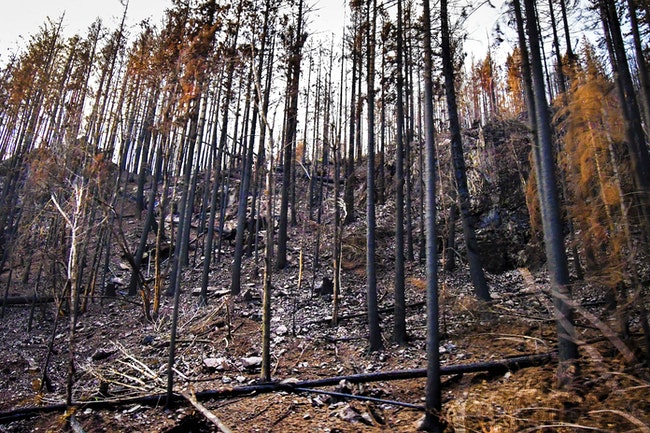
In the heavily fire damaged North Santiam watershed, hillsides where trees and plants were burned in the wildfire are at increased risk of flooding and mudslides. (Ron Cooper/Salem Reporter)
Oregon will face more mudslides and flooding during the next 80 years as a result of extreme wildfires followed by extreme rains, according to scientists in Colorado, California and Washington.
The findings, published in Science Advances – the journal of the American Association for the Advancement of Science – show that extreme wildfire events across the West will increase in the next several decades, and by the later half of the century, extreme rainfall events will be just as common.
The combination of the two will lead to greater risk of flood and mudslides due to landscapes destabilized by fires, the scientists concluded.
Danielle Touma is a climate scientist at the National Center for Atmospheric Research in Boulder, Colorado, who worked on the study with researchers from the University of California in Santa Barbara and from Washington State University in Vancouver.
“You’re getting an increase in one of these ingredients at the beginning of the 21st century,” Touma said, “and by the end of the 21st century you’re getting both.”
She said that of the 11 states they looked at, Oregon “will have the largest changes in terms of extreme weather events.”
Maps of wildfire and rainfall projections show the greatest growth in fire and rainfall will occur in eastern Oregon. Touma said she and her colleagues ran hundreds of years of climate data to reach their projections, but did not explore why the eastern half of the state appears to have more fire and rain events through the rest of the century.
Touma cited ongoing drought in the eastern part of Oregon as well as effects of air pressure and temperature increases east of the Cascades in the decades ahead.
The projections were based on greenhouse gas emissions continuing without climate mitigation efforts outlined in the Fifth Assessment Report of the United Nations Intergovernmental Panel on Climate Change. That report was published in 2014.
The final installment of the Sixth Assessment Report was published Monday, and showed that while there is evidence of some countries decreasing greenhouse gas emissions since 2014, emissions overall during the last decade were the highest in human history.
The frequency and duration of wildfires and heavy rains in the West has accelerated due to human-caused climate change, according to the scientists. Without global climate mitigation, Oregon could face up to seven extreme wildfires and seven extreme rainfall events per year by 2100, according to the study.
“Our results point to a future with substantially increased post-fire hydrologic risks across much of the western United States,” the report states.
While rains following a fire might sound beneficial, Touma said it’s a recipe for mudslides, floods and destruction.
“Extreme rain can be detrimental after a fire,” Touma said. “The landscape changes a lot. It loses vegetation, the soil becomes hydrophobic so it repels water, it doesn’t absorb it.”
The loss of vegetation means a loss of root systems holding soil in place. Layers of burned debris on the surface flow into waterways and down slopes.
“Sometimes you don’t even need that much rainfall to trigger an event,” she said.
The scientists found that impacts are greater when extreme rainfall occurs within one or two years after a wildfire, because there is still a large amount of surface debris and loose soil.
Within five years of an extreme wildfire event, the scientists predict Oregon would see at least three rain events following in an impacted area.
Oregon Capital Chronicle is part of States Newsroom, a network of news bureaus supported by grants and a coalition of donors as a 501c(3) public charity. Oregon Capital Chronicle maintains editorial independence. Contact Editor Les Zaitz for questions: [email protected]. Follow Oregon Capital Chronicle on Facebook and Twitter.
STORY TIP OR IDEA? Send an email to Salem Reporter’s news team: [email protected].









